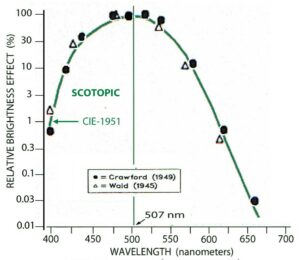Main Body
15 PHOTONS VARY IN VISUAL EFFECTIVENESS
(But It’s Not Their Fault) p. 48
The response of visual receptors to various wavelengths can now be directly measured using micro-electrodes. Yet receptor response is only a first step. Brightness results from complex neural processing that culminates as a conscious experience. This experience can not be measured directly. Therefore we must still rely on brightness matching to find the relative visual effectiveness of different wavelengths.
This relative effectiveness function enables weighting a detector’s energy reading at various wavelengths to obtain a number that approximates brightness. The required brightness matching method is essentially the same as what Thompson used – only repeated at many wavelengths.
However, doing so is more complicated than you might think. Physics is simple compared to vision:
p.49
1. The visual effectiveness of photons differs substantially for two types of receptors:
photopic receptors operate in daylight conditions.
scotopic receptors operate at night and are 100 X as sensitive.
2. The sensitivity of both types increases or decreases over time to compensate for (adapt to) decreases and increases in the overall level of light.
During dark adaptation, photopic receptors reach maximum sensitivity after about 10 minutes; the scotopic receptors after about 30 minutes.
By comparison light adaptation (going from darkness to a bright region) is remarkably fast – most of it occurring within a few seconds for both types.
(Briefly turn on a lamp to record a measurement, and you must dark adapt all over again.)
3. The number of each type of receptor varies greatly with location on the retina.
Therefore the results differ depending on where the observer looks to make the matches.
4. The two types differ in sensitivity to wavelength.
5. Different wavelengths acting on the photopic receptors result in different colors as well differences in brightness.
6. Even when the matches are made by observers who by other tests have normal color vision, individual differences can be substantial – plus or minus 10 % or more even after substantial practice.
p. 50
These visual factors have been controlled by making the brightness matches when the eyes have been fully dark adapted, presenting the image at the same place on the retina, using the same size image for all wavelengths, averaging the results for ten or more experienced observers, and averaging the results from several laboratories. Different matching methods were used to minimize the effects of color differences on brightness judgement – particularly for the daylight conditions that involve photopic receptors.
Based on many such measurements, the International Commission on Illumination (CIE – Commission Internationale de l’Eclairage) created two standards: photopic for daylight conditions and scotopic for night time conditions to describe visual sensitivity as a function of wavelength.
Avoiding the pros and cons of the different “matching” methods, the general procedure goes as follows:
Photopic matching is done by adjusting the amount of energy at each wavelength to equal the brightness of constant “white” (e.g. 3,000o K Black Body – page 3) spot of light set to a moderately bright daylight condition such as 100 candelas/meter2 (brightness of white paper in a classroom – page 86). The relative values of those energy matches can then be used to correct energy measurements to numbers that represent apparent brightness – approximately.
These factors can be used by analyzing any light into its constituent wavelengths, applying the factor to each wavelength’s energy measurement, and the total summed. However, a more convenient way is usually satisfactory. By adding to the energy sensor a filter whose wavelength transmission matches these relative values, a single energy measurement is corrected for all wavelengths present.
These relative values are sufficiently consistent, so that various wavelengths still look equally bright enough for most purposes across a wide range of light energy levels. In practice a single set of corrections has proven more useful than attempts to apply various corrections depending on the amount of light, size and direction of the area being measured, etc. Such conditions are then described separately.
p. 51
555 nanometer photons produce the brightest response in the photopic system.

Light at this wavelength had to be reduced by a factor of 100 to match the brightness resulting from 400 and 700 nm photons.
In other words, for the same energy reading, 400 and 700 nm photons produce only 1 percent as much brightness as 555nm photons.
Matching to the other wave- lengths provided a scale of the visual system’s relative brightness response:10
Accordingly, energy readings at any wavelength can be converted to reflect relative brightness by multiply the
reading by that wavelength’s percent relative brightness effect.
The CIE publishes these correction factors for energy measurements as a function of wavelength.11 In practice, photopic light meters are made with sensors whose sensitivity is filtered to match this photopic brightness function.
p. 52
Sensitivity of the scotopic system to various wavelengths was measured in terms of the minimal amount of light needed to detect some brightness – the system’s threshold.(It is tacitly assumed that at threshold the wavelengths are matched as equally “dim”.)

Photons at 507 nm required the least light, so their relative effectiveness was set to 100%.
Photons of other wavelengths required more light to be seen. For example, 400 nm photons required over 100 times more light – thus being less than 1% as effective:12
A light meter with a detector whose sensitivity matches this brightness function will provide readings of dim lights that are comparable to their brightness. Nonetheless, scotopic measurements are often used simply to determine whether dim lights can or can not be seen.
You might also wonder how light is measured in twilight conditions that fall between the photopic and scotopic. (Then again, you might not).
However, think about it. These may be the very conditions in which being able to provide adequate light becomes really important.) For various levels of dimness, a series of relative brightness functions have been measured by the matching method. These are proposed as mesopic standards.13
